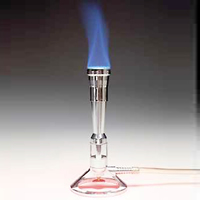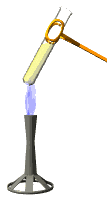Safety in practical lessons that use HEATING EQUIPMENT
Things to consider when heating...
- In Physics we rarely have to heat anything more hazardous than water but that can lead to complacency. Any substance other than water to be heated should be checked on the HAZCARDS. These are kept in the Chemistry prep room.
General Rules when 'heating'
- All pupils should tie their hair back if it falls on their face or shoulders.
- All pupils should wear lab-coats and goggles throughout the whole practical session.
- No one should ever have the mouth of a vessel facing towards him/her when it is being heated.
- Pupils should be actively reminded of the risks involved in the procedure undertaken.
- Heat proof mats should be used to stand equipment on.
- No cracked or chipped glassware should be heated.
- No sealed container should be heated.
 Bunsen burners should be set to:
Bunsen burners should be set to:
- luminous flame (closed hole) when not actively heating a substance - resting flame.
- hole should be half open for heating substances in test tubes
- hole should be fully open (set to Bunsen flame) when heating large volumes of liquid or solid pieces.
No hot equipment must be put away into the cupboards at the end of the session. It should be clearly marked and put aside safely.
The heating of solids
- Solid strips of pieces can be held in tongs to heat. If incorrectly used, these can cause accidents. The tongs are metal. If the pupil holds them in the flame as well as the object being heated they can get very hot and even glow red or white. The heat is conducted up to the child's hand and can cause her to drop the tongs. Therefore heating over a heat proof mat is important. There must be somewhere safe for the child to rest hot objects safely.
- Solids with 'hairline cracks' or air bubbles in their construction in them can explode when heated.
- Solids in powder form can ignite very easily or the air between the particles rapidly expand causing the powder to shoot up the tube.
The heating of liquids
- Never overfill a vessel (liquids appreciably expand when heated)
- Remember that a stirring rod/thermometer can make a beaker of liquid unstable and likely to tip.
 No one should ever have the mouth of a vessel facing towards him/her when it is being heated.
No one should ever have the mouth of a vessel facing towards him/her when it is being heated. - A test tube of liquid should be constantly moved through the flame so that the liquid is evenly heated - small pockets of very hot liquid can expand/evaporate rapidly and spurt up the tube!
- Once hot, a beaker of liquid should not be left standing on top of a tripod and gauze while the pupil sits to write up the experiment. It should be lifted down to a low level as soon as possible to minimise the hazard.
The heating of gases
- A heated closed volume of gas is a bomb! This should never be done in the laboratory unless it is as a demonstration with a pressure resistant container to illustrate the gas laws. A safety vent should always be present!
Extracted from WGHS Physiscs Department hHandbook written by L.O. Jones 2005



 Bunsen burners should be set to:
Bunsen burners should be set to:  No one should ever have the mouth of a vessel facing towards him/her when it is being heated.
No one should ever have the mouth of a vessel facing towards him/her when it is being heated. 


